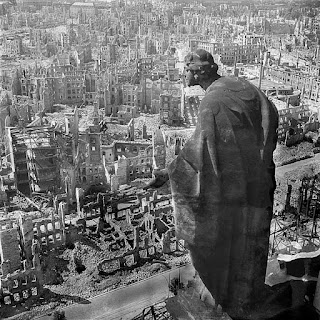In the winter of 1945, Dresden’s normal population of about 600,000 had been swelled by several hundred thousand refugees, fleeing from the advancing Soviet army.
In the winter of 1945, Dresden’s normal population of about 600,000 had been swelled by several hundred thousand refugees, fleeing from the advancing Soviet army.
The seventh largest city in Germany, Dresden was an important industrial center and transportation hub. It was also renowned for its beautiful art and architecture, known throughout the world as “Florence on the Elbe.” In February 1945, Dresden was the largest remaining German city that had not been the target of a major Allied bombing raid.
Although by then it was clear to the Allies that Germany was going to be defeated, how quickly and at what cost was still unknown. One of the high priority targets that had been identified by RAF Bomber Command was Dresden, in part to assist the Soviet offensive in east Germany. In late January RAF Bomber Command ordered that Dresden be bombed as soon as weather permitted.
Allied plans called for the attack to begin with a daylight raid by U.S. bombers, but weather forced the cancellation of that mission. The planned follow-up night attack by British bombers proceeded, however, and at around 10:15 p.m. on February 13, a wave of over 200 British Lancaster bombers dropped 880 tons of incendiary bombs on the Dresden city center.
Three hours later, as firefighters and rescue crews were battling the fires, a second wave of 550 Lancasters reached the city, dropping another 1,800 tons of bombs. The city was a blazing inferno when at around noon the next day (Ash Wednesday) over 200 American B-17’s arrived, releasing another 700+ tons of bombs onto the city.
German air defense was minimal, as the German air force had been by then largely destroyed and most anti-aircraft guns had been removed and sent to the front. Only 7 Allied bombers were lost in the attack—6 British and 1 American. Three of the lost British bombers were hit by bombs dropped from planes flying above them.
It is impossible to know the exact number of civilians killed in the raid, and estimates vary wildly. The most commonly accepted estimates range from 20,000 to 35,000.
The Dresden bombing attack was immediately controversial, and the debate still rages on.
Notwithstanding their own history of bombing civilian populations in Great Britain, the Nazis used the raid for propaganda purposes—circulating photos of the charred bodies of women and children and claiming (falsely) that there had been no military facilities or industries in Dresden.
Within the Allied and neutral countries, the raid was, at a minimum, discomforting, particularly in light of Dresden's cultural significance, with some criticizing the bombing as cruel, inhumane, and militarily unnecessary.
Although the subject remains controversial, postwar analysis by the British and U.S. militaries concluded that the raid was justified and militarily necessary, based on the intelligence available at the time.
The Dresden bombing raid began on February 13, 1945, seventy-eight years ago today.
The iconic photo of the ruins of Dresden was taken from the city’s town hall tower, looking over the shoulder of August Schreitmüller's 1910 statue titled "Güte" (meaning "Goodness" or "Kindness.")


.jpg)

.jpeg)






Comments
Post a Comment